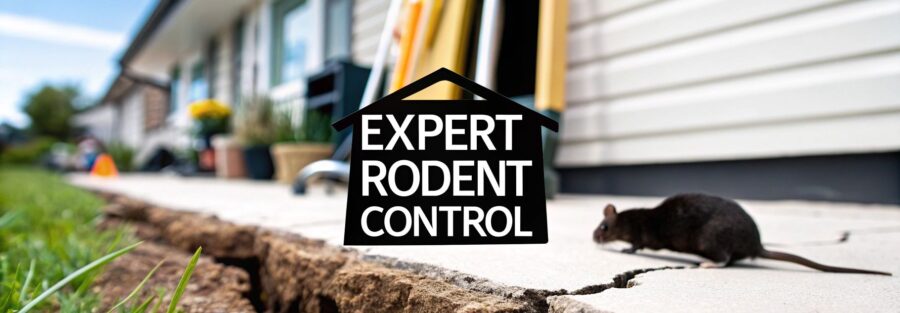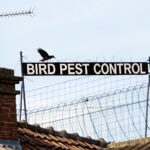It's a moment no homeowner wants: the flicker of movement in the corner of your eye, the tell-tale scratching from inside a wall. Finding a rat or mouse in your home is deeply unsettling, and if you're dealing with rodent control in Wolverhampton, you need to act fast. That one little intruder is almost never alone—it's usually the first sign of a much larger, hidden colony.
The Hidden Rodent Problem in Wolverhampton
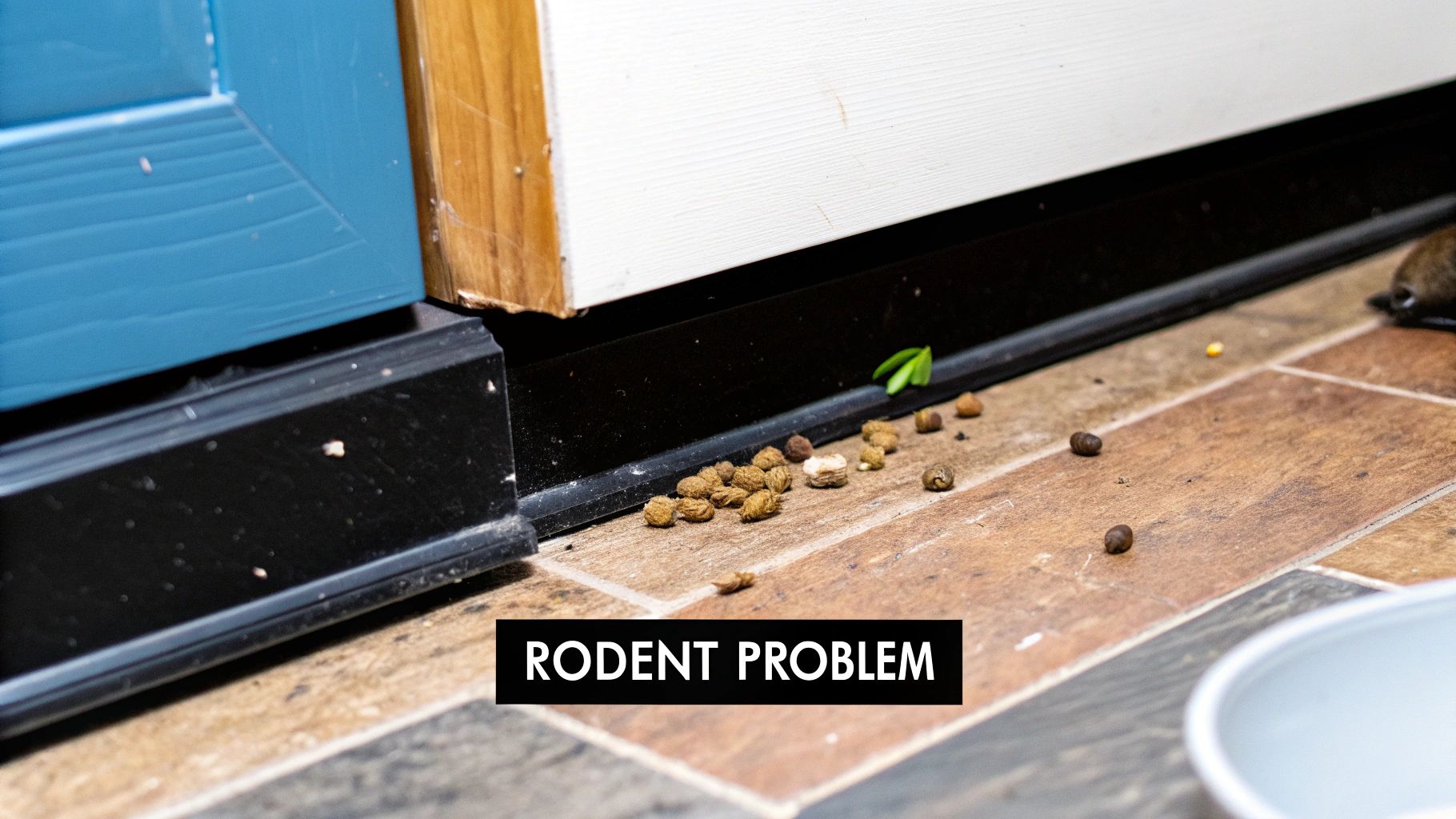
First things first: finding evidence of rodents doesn't mean your home is unclean. It’s an incredibly common challenge for people right across the city. Think of a rodent infestation like an iceberg. The one mouse you spot scurrying across the kitchen floor is just the tip. Beneath the surface—tucked away in wall cavities, lofts, and under the floorboards—a much bigger problem could be brewing.
Urban areas like Wolverhampton are a perfect playground for rats and mice. With plenty of people, endless food sources from bins and gardens, and countless older buildings offering warm shelter, they have everything they need to thrive. This guide is here to walk you through every step of taking back your home, giving you the expert advice you need for lasting peace of mind.
Why Rodent Issues Are on the Rise
This isn't just a local issue; it’s part of a national trend. Across the UK, local authorities had to deal with over 225,000 residential rodent infestations in 2022 alone. That breaks down to a staggering 618 call-outs every single day.
This figure is up 12% since 2020, which shows just how widespread the problem is becoming. Councils are spending around £36 million a year on pest control visits to try and keep up. You can learn more about these national pest control statistics and see how communities are being affected.
A rodent problem is far more than an inconvenience. It’s a direct threat to your family’s health, your property’s structural integrity, and your overall sense of security at home. Ignoring the signs is never a safe or effective option.
This guide will give you the knowledge to handle this challenge head-on. We'll cover everything from figuring out exactly what kind of pest you're dealing with to putting professional-grade prevention strategies in place.
What This Guide Covers
To give you a complete roadmap for effective rodent control in Wolverhampton, we’ll break down several key areas to make sure you feel confident and prepared:
- Identifying the Intruder: Learn the crucial differences between common culprits like the Brown Rat and the House Mouse.
- Understanding the Risks: We’ll look at the health hazards and potential property damage that come with an infestation.
- Rodent-Proofing Your Home: Get practical, step-by-step instructions to make your property an unwelcome place for pests.
- DIY vs Professional Solutions: Figure out when you can tackle it yourself and when it’s time to bring in the experts.
By the end of this guide, you’ll have a clear picture of why rodent problems happen and exactly what you can do about them. Consider this your go-to resource for sorting any rodent issue safely and for good.
Identifying The Intruders In Your Home
Before you can tackle a rodent problem, you need to play detective. Figuring out whether you have rats or mice is the first, most crucial step towards getting them out of your Wolverhampton home for good. It’s a bit like a doctor diagnosing an illness before prescribing medicine – get the diagnosis wrong, and the treatment will fail.
This isn’t about becoming a zoologist. It’s about learning to spot a few simple, practical clues. The two most common culprits you’ll encounter are the Brown Rat (Rattus norvegicus) and the House Mouse (Mus musculus). They might look similar at first glance, but their size, behaviour, and the evidence they leave behind are worlds apart.
The guide below breaks down what you're looking for.
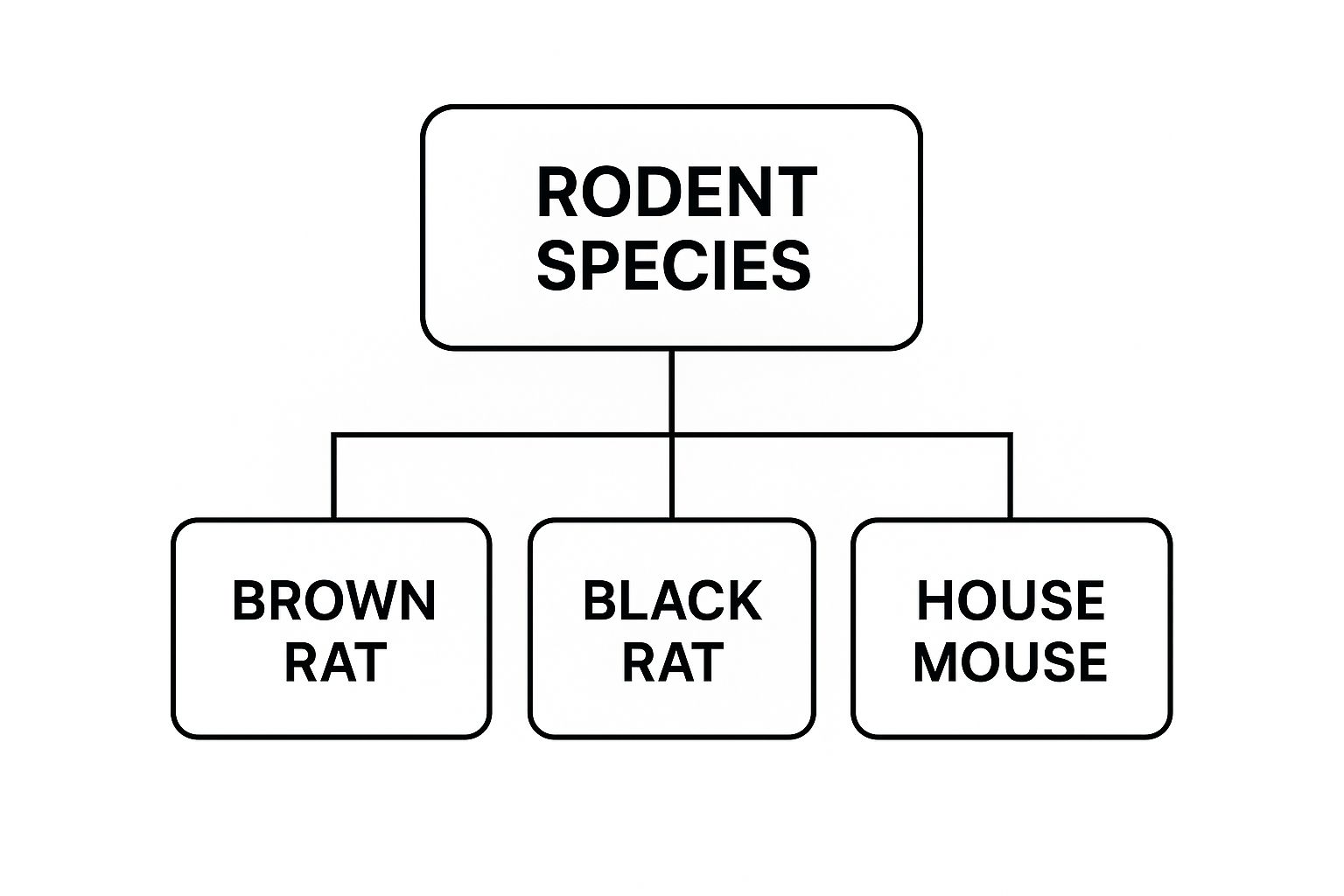
As you can see, while Black Rats exist in the UK, it’s the Brown Rat and the House Mouse that you really need to get to know.
Brown Rats: The Main Wolverhampton Culprit
Here in Wolverhampton, the Brown Rat is public enemy number one. It's the most widespread rodent across the entire UK and the primary cause of household infestations right here in our city. Their incredible adaptability and shockingly fast breeding cycles mean a small issue can spiral into a major problem before you know it.
These larger rodents are smart and naturally cautious, often avoiding new objects placed in their environment. This "neophobia" (a fear of new things) can make trapping them a real challenge for the average homeowner. They prefer to burrow outdoors but will happily move into wall cavities, under floorboards, or into loft spaces for warmth and easy access to food.
House Mice: The Smaller, Bolder Invaders
House mice are much smaller than rats and tend to be a bit more curious and bold. Where a rat might cautiously skirt the edge of a room, a mouse is more likely to be seen darting right across an open floor. Their tiny size is their superpower, allowing them to squeeze through gaps as small as the width of a pencil.
Because they’re naturally inquisitive, mice often investigate new things, which can make them slightly easier to catch with traps than their larger, warier cousins. They almost always nest indoors, favouring warm, secluded spots close to a food source—think behind the fridge or inside kitchen cupboards.
To make it easier, here's a quick reference guide to help you tell them apart at a glance.
Rat vs Mouse Quick Identification Guide
| Feature | Brown Rat (Rattus norvegicus) | House Mouse (Mus musculus) |
|---|---|---|
| Size | Large and stocky, up to 25 cm (10 inches) long. | Small and slender, 7-10 cm (3-4 inches) long. |
| Droppings | Blunt, capsule-shaped, like a large raisin. | Small, pointed ends, like grains of rice. |
| Tail | Thick and scaly, shorter than its body. | Thin and long, often as long as its body. |
| Ears | Small and furry, not very prominent. | Large and prominent, like "Mickey Mouse" ears. |
| Snout | Blunt and rounded. | Small, pointed, and triangular. |
| Behaviour | Cautious and avoids new objects (neophobic). | Curious and investigates new things. |
| Gnaw Marks | Large and coarse, about 3 mm wide. | Small and scratchy, like fine score marks. |
Getting this right is fundamental to choosing a strategy that actually works. For a deeper dive, check out our guide that explores the differences between mice and rats.
Of course, rodents might not be your only uninvited guests. Knowing how to spot other common pests is key to keeping your home protected. Learning about identifying other common household intruders like carpet beetles gives you a more complete approach to home pest control. The bottom line is, once you know exactly what you're dealing with, you’re already one step closer to a solution.
Understanding the Risks of a Rodent Infestation
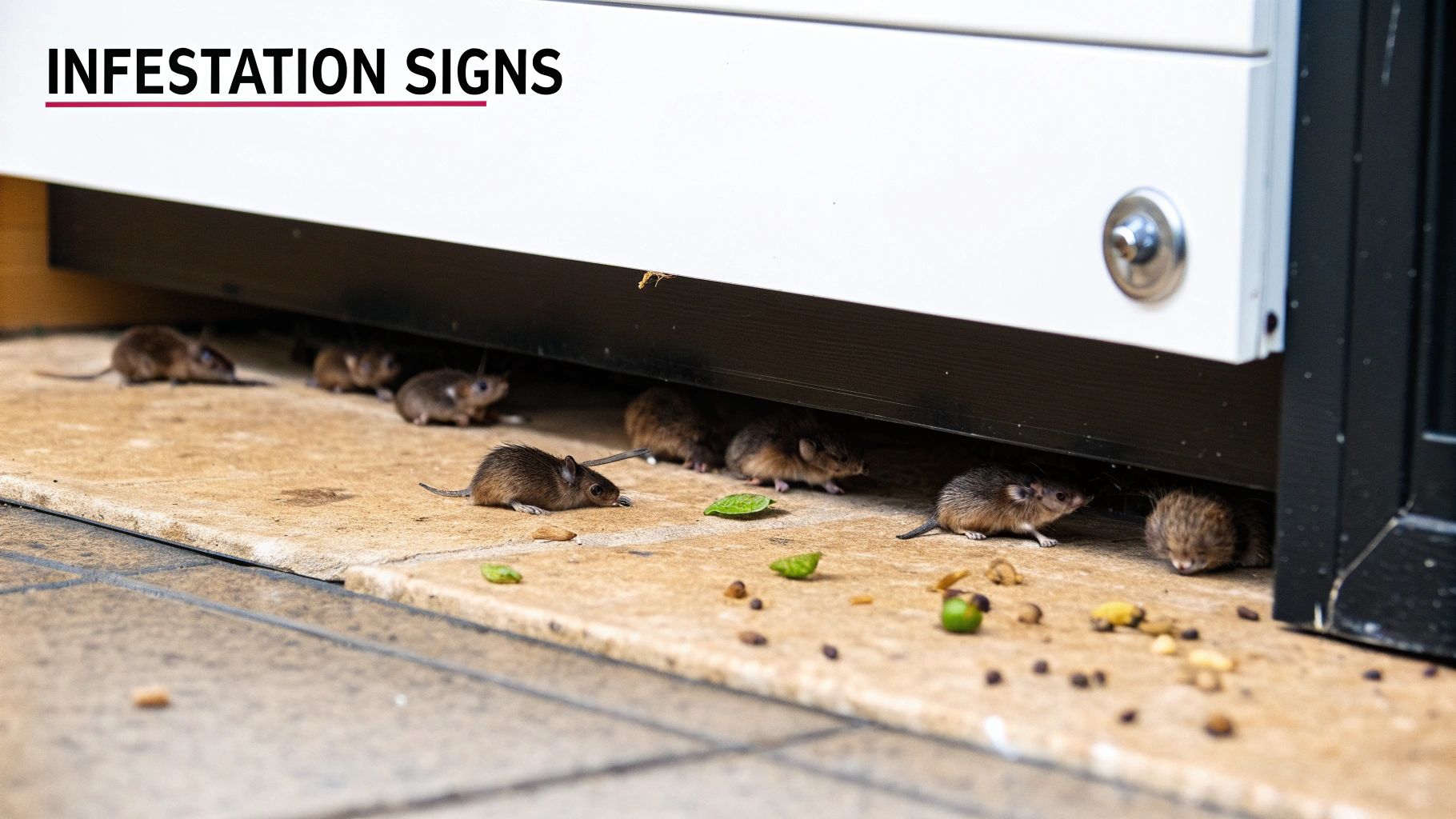
Spotting a rat or mouse scurrying across the floor is more than just a momentary shock. Think of it as a warning bell for much deeper problems threatening both your property and your family’s wellbeing. Ignoring it is never a good idea, as an unchecked infestation can lead to serious, far-reaching consequences.
A rodent problem is a direct threat to your home’s structure and your health. When you understand the full scope of these risks, it becomes clear why swift and effective rodent control in Wolverhampton isn't just a recommendation—it's absolutely essential.
Health Hazards Hiding in Plain Sight
Rodents are like tiny, mobile biohazards, carrying a nasty collection of harmful bacteria, viruses, and parasites wherever they go. They contaminate every surface they touch with their urine, droppings, and saliva.
This contamination poses a very real risk to your family. Diseases can spread in a few different ways:
- Direct Contact: Simply handling a rodent, whether it's alive or dead, can transfer pathogens.
- Contaminated Food: Eating or drinking anything a rat or mouse has crawled over or urinated on.
- Inhaling Contaminated Dust: When their droppings and urine dry out, the particles can become airborne if disturbed, leading to illness when inhaled.
In the UK, some of the most serious diseases linked to rodents include Salmonella, which causes nasty food poisoning, and Leptospirosis (also known as Weil's disease). This is a serious bacterial infection spread through rat urine that can even lead to organ failure.
Beyond the visible damage, rodent infestations in your home can lead to serious consequences, including the spread of diseases and allergens, directly contributing to health problems associated with dirty air ducts, making professional intervention crucial.
The Destructive Nature of Rodent Infestations
On top of the health concerns, rodents are relentless little demolition artists. Their front teeth never stop growing, which means they have to chew constantly to keep them filed down. Unfortunately for homeowners, they aren’t fussy about their choice of chewing material.
This non-stop gnawing results in significant, and often hidden, property damage. It’s like having unwanted, destructive tenants living in your walls, causing chaos where you can’t see it until it’s a major problem.
Common targets for their destructive habits include:
- Electrical Wires: This is easily one of the biggest dangers. Frayed and gnawed wires create a serious fire hazard and are a leading cause of house fires.
- Insulation: Rodents love to shred loft and cavity wall insulation to bits to build their nests. This ruins your home’s energy efficiency and drives up your heating bills.
- Structural Timbers: Over time, their constant gnawing can weaken wooden beams and joists, putting your home’s structural integrity at risk.
- Pipes: They can chew through plastic and even lead pipes, causing leaks that lead to serious water damage.
They will also happily ruin personal belongings, contaminate any food they can find, and create a persistent, unpleasant smell throughout your property. The cost of repairing all this damage often ends up being far more than the cost of professional pest control. Tackling the problem at the very first sign is always the smartest move to protect your home and your health.
Your Guide to Rodent-Proofing Your Home
The best way to control rodents isn't about setting traps once they're already inside; it’s about making your home a fortress they can't get into in the first place. This proactive strategy, known as proofing, is hands down the most effective long-term solution. Think of it this way: you wouldn't leave your front door wide open and then complain about the flies. Rodent-proofing is all about finding and locking every tiny "door" and "window" these pests use to sneak in.
It takes a bit of detective work and some hands-on effort, but it’s worth it. By sealing up entry points, cutting off their food supply, and removing potential hiding spots, you make your property completely uninviting. A well-proofed home sends a very clear message to any scouting rat or mouse: "Nothing to see here, move along."
Sealing Every Crack and Crevice
You’d be amazed at what rodents can get through. A young mouse can squeeze through a gap the size of a pen (6 mm), while a small rat only needs a hole as wide as your thumb (20 mm). This is why a thorough inspection of your home's exterior is the absolute first step. You need to get down on their level and think like a pest, hunting for any small vulnerability they could exploit.
Start by walking the perimeter of your property. Pay close attention to these common weak spots:
- Around Pipework: Check where water, gas, or electrical pipes enter your walls. Gaps here are a classic entry point.
- Foundations and Brickwork: Look for any cracks in the foundation or crumbling mortar between bricks.
- Air Bricks and Vents: These are essential for ventilation but are basically open doors for pests. They have to be covered.
- Under Doors: Big gaps under garage doors or back doors are like a welcome mat for rodents.
Once you’ve found the gaps, you must seal them with materials rodents can't simply chew through. Don't bother with silicone sealants or expanding foam on their own—a determined rat will make short work of them.
Your goal isn't just to fill a hole; it's to build a barrier they can't breach. Using the right materials is non-negotiable for lasting rodent control in Wolverhampton homes.
Choosing the Right Materials
To properly block these entryways, you’ll need a few durable supplies. Here’s what actually works:
- Wire Wool or Steel Wool: Stuff this tightly into smaller holes. Rodents hate the feeling of chewing on steel; it’s abrasive and painful for them.
- Cement Mortar: For any gaps in your brickwork or foundations, a proper mortar repair is the only truly permanent fix.
- Metal Plating or Mesh: Use galvanised steel plating or strong wire mesh to cover larger openings. This is perfect for reinforcing vents or damaged areas.
One of the most commonly overlooked entry points is the humble air brick. Installing professional-grade mesh air brick covers is a simple but incredibly effective measure that stops rodents dead in their tracks without blocking vital airflow to your property.
Eliminating Food and Water Sources
Even a perfectly sealed house can attract rodents if your garden and bins are an all-you-can-eat buffet. Pests are driven by the search for food, water, and shelter. Take those away, and your property instantly becomes less appealing.
Start with your rubbish. Make sure all your outdoor bins have secure, tight-fitting lids that can’t be easily knocked over or gnawed through. If you compost, use a rodent-resistant bin and never add cooked food, meat, or oily scraps that rats love.
Inside, be strict with your food hygiene. Store dry goods like pasta, cereal, and pet food in airtight containers made of glass, metal, or hard plastic. A flimsy cardboard box is no challenge for a hungry mouse. Clean up spills and crumbs right away, and never leave pet food sitting out overnight.
Finally, cut off their water supply. Fix dripping outdoor taps, clear any blocked drains, and get rid of any standing water in your garden. A tiny, consistent puddle is all a rodent colony needs to set up camp.
When to Choose DIY Rodent Control Methods

It’s tempting to try and tackle a rodent problem yourself. After all, it seems like a quick and cheap fix, right? And sometimes, for a very small-scale issue, it can be. If you’ve just seen the first sign of a single house mouse and you’ve been quick to clear away any food sources, a DIY approach might just nip the problem in the bud.
This puts you in the driver's seat, letting you take immediate action. But it's vital to go in with your eyes open, understanding what DIY methods can achieve and, more importantly, what they can't. Setting realistic expectations is the difference between solving a minor nuisance and letting it spiral into an entrenched infestation.
Assessing the Situation
First things first, you need to be honest about the scale of the problem. A DIY approach really only works for what we call a "low-level" infestation. This means the evidence is minimal—perhaps a few droppings in one small area, and definitely no scratching sounds coming from the walls or ceiling.
Here’s a good rule of thumb:
- One-off Sighting: You've seen a single mouse once and found no other trace.
- Localised Droppings: You've found a small cluster of droppings in a single cupboard or behind one kitchen appliance.
- No Other Signs: There are no chew marks on skirting boards, no nests, no greasy smear marks, and no persistent, musty smells.
If this sounds like your situation, then carefully placed traps are a decent starting point. However, if you're seeing signs in multiple rooms, hearing noises at night, or you know you're dealing with rats, the odds are already stacked against you.
For established infestations, especially those involving naturally wary rats, DIY methods are rarely enough. These scenarios almost always require professional rodent control in Wolverhampton to get a proper, lasting solution.
Common DIY Tools and Safety First
When you head to the hardware shop, you’ll find a few standard options on the shelves. Knowing how they work—and their pros and cons—is crucial for using them safely and effectively.
1. Snap Traps: The classic, spring-loaded trap. When used correctly for mice, they are effective and provide a quick, humane end.
- Pros: They're cheap, reusable, and give you undeniable proof of a catch.
- Cons: You have to be extremely careful where you place them to avoid injuring children and pets. Wary rats will often avoid them completely.
2. Bait Stations: These are the enclosed plastic boxes you see, which hold poison bait blocks inside. The rodent goes in, eats the bait, and leaves.
- Pros: The tamper-resistant design makes them much safer for homes with kids or pets.
- Cons: You have zero control over where the rodent dies. This can lead to a horrendous smell coming from an inaccessible spot, like inside a wall. Plus, the poisons available to the public are much weaker than professional-grade rodenticides.
Safety has to be your number one priority. NEVER put open bait or an uncovered snap trap anywhere a child or pet could get to it. Always place them inside cupboards, behind heavy appliances, or in attic spaces where non-target animals can't reach them.
And always, always read and follow the manufacturer's instructions. If the problem is still there after a week of your best efforts, it's a clear signal that the infestation is bigger than you thought. It's time to stop wasting time and money, and call in the professionals.
When to Call in the Professionals for Rodent Control
Let's be honest, DIY traps might catch the odd mouse that’s wandered in by mistake. But a full-blown infestation? That’s a completely different ball game.
When you’re dealing with a persistent rodent problem, you’re not just up against the pests you can see. You're fighting a hidden, fast-breeding colony that’s incredibly smart and adaptable. This is the point where calling for professional rodent control in Wolverhampton isn't just a good idea—it's essential.
Think of a professional pest controller less like an exterminator and more like a detective. They have the experience to look past the obvious signs and diagnose the root cause of your infestation, not just treat the symptoms. It's a strategic process built on years of understanding how these pests think and behave.
The Professional Game Plan
When you bring in an expert, they don't just turn up and scatter poison around. A reputable service follows a clear, structured plan to make sure the problem is gone for good.
Here’s what that typically looks like:
- A Thorough Inspection: They’ll survey your entire property, meticulously identifying where rodents are active, how they’re getting inside, and what’s attracting them in the first place.
- Correct Species ID: As we’ve already discussed, rats and mice need very different approaches. An expert can tell exactly what you’re dealing with and create the right strategy.
- A Targeted Treatment Plan: Based on their findings, they’ll put a bespoke plan into action using commercial-grade tools and products far more effective than anything you can buy in a shop.
- Future-Proofing Your Home: The job isn’t done when the pests are gone. A true professional will help you secure your property by sealing up entry points to prevent another invasion down the line.
Deeper Knowledge and Better Tools
One of the biggest advantages a professional brings is their toolkit. They have access to powerful, commercial-grade rodenticides that work faster and more effectively than anything available off the shelf. Crucially, they know how to use them safely inside tamper-resistant bait stations, keeping your family and pets protected.
Their understanding of rodent behaviour is just as important. They know all about things like rat neophobia (a rat’s natural fear of new objects) and how to place traps and bait in a way that overcomes it. They can read the subtle clues of an infestation—smear marks on skirting boards, gnawing patterns, and the location of droppings—to pinpoint nests and high-traffic routes.
Professional intervention is about getting a definitive, long-term solution. It's an investment in the safety of your property, the health of your family, and your own peace of mind.
The scale of the problem right here in our city really highlights this. In a single year, Wolverhampton services recorded 947 requests for pest control. A staggering 409 of those were for rats, making them the number one rodent challenge for local residents. You can learn more about the pest control challenges in Wolverhampton to see just how common this is.
Choosing a Reputable Wolverhampton Company
When you’re ready to hire someone, you need to know they’re qualified and trustworthy. Always look for a company that is a member of the British Pest Control Association (BPCA).
This certification is your guarantee of quality. It means the technicians are properly trained, fully insured, and follow strict industry standards. Don't be afraid to ask for proof of their insurance, and be wary of any company that isn’t upfront about their methods and pricing from the very start.
Common Questions About Rodent Control
Even when you feel you have a handle on things, it’s completely normal to have a few lingering questions when you’re up against a rodent problem. We’ve pulled together some of the most common queries we get from Wolverhampton residents to give you that extra bit of clarity before you take the next step.
Think of this as a quick-fire round, tackling those practical concerns about cost, safety, and tricky neighbour situations.
How Much Does Rodent Control Cost?
Let’s be honest, this is often the first question on anyone’s mind. The cost for professional rodent control in Wolverhampton isn't a one-size-fits-all figure; it really depends on the size of your property and just how bad the infestation has become.
As a rough guide, an initial visit—which covers a full inspection and the first round of treatment—typically falls somewhere between £80 and £200. Of course, a more stubborn problem that needs several follow-up visits or extensive proofing work will cost more. The best advice? Always ask for a detailed, written quote so there are no nasty surprises. You need to know exactly what you’re paying for. For a deeper dive into pricing, you can learn more about the cost of pest control for rats in our dedicated guide.
Are Professional Treatments Safe for My Family and Pets?
Absolutely. This is non-negotiable for any reputable, certified pest controller. Our entire job revolves around using powerful, professional-grade products in a way that poses minimal risk to your family and furry friends.
A key part of professional service is the use of tamper-resistant bait stations. These are essentially locked plastic boxes. Rodents can get in, but they’re designed specifically to keep curious children and pets out.
Your technician will place these stations in strategic, out-of-the-way spots—think lofts, voids under kitchen units, or tucked away behind bulky appliances. They’ll also give you clear, simple instructions, like keeping a pet out of one room for a few hours, just to be doubly sure everyone stays safe while the treatment gets to work.
What If My Neighbour Has Rodents?
This is an incredibly common headache, especially in terraced or semi-detached houses. The simple truth is that rats and mice don’t care about property boundaries. They’ll happily travel between homes through shared wall cavities, roof spaces, or under the floorboards.
The only real way forward is to work together. Start with a friendly chat with your neighbour—they might not even be aware of the problem, or they could be trying (and failing) to deal with it themselves. Trying to treat just your side of the wall when the main nest is next door is a losing battle. A coordinated effort, where both properties are treated and proofed simultaneously, is far more effective and is the only way to get a lasting solution for everyone. Many Wolverhampton pest controllers are well-versed in this and can create a block treatment plan for adjoining homes.
For expert advice and a definitive solution to your rodent problem, trust the professionals at Pest Predators Limited. Book your consultation today and restore peace of mind to your home.

